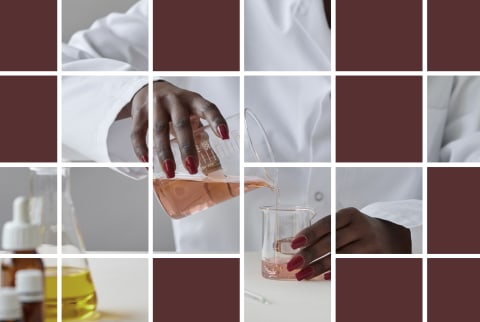Practically every facet of our culture has some sort of galactic or futuristic element (perhaps due to the rise of the metaverse?). During a recent chat at Condé Nast, Kim Kardashian described her personal style as “Future Alien Barbie.” Model Bella Hadid had a dress literally sprayed on her body during the Coperni show at Paris Fashion Week. Scroll through your social media feeds, and you’ll see a slew of “chromecore” looks that practically scream Space Age. The future is now—and for beauty, it’s much more than an affinity for silver shadow and an alien-like aesthetic. For beauty, the future is in biotechnology. “A lot of people don’t know that the lactic acids, the sodium hyaluronates, and some of the peptides and biosaccharides that are used in beauty are all derived using biotechnology,” explains clean cosmetic chemist Krupa Koestline. Fermented ingredients, too, have been part of the zeitgeist for a very long time: SK-II, for example, has used ferment filtrates for years, most famously in their cult-favorite Facial Treatment Essence. There’s even a 1933 study1 that documents the production of butylene glycol by fermenting plant-based sugars. To be clear: These ingredients still come from plants—well, at least from their cells. Think of them as the “next generation” of naturals manufactured with modern biotechnology methods (like cell cultures), which often makes them more effective than their agriculture counterparts. “Biotechnology can provide more highly concentrated bio-actives into a formulation, thereby increasing the efficacy of a skin care product,” says Barb Paldus, Ph.D., founder of Codex Labs. “The concentration can be up to 100 times from a typical natural extract.” For example, Acaderma’s Oasis Barrier Booster Serum calls upon an exclusive kinkeliba tea extract (which typically grows in sub-Saharan Africa) that’s 20% more effective than resveratrol and boasts higher antioxidant levels than green tea. “We use TLC (thin-layer chromatography) profiling, column chromatography, and supercritical fluid extraction technologies to identify each compound and concentrate the target fraction with the most potent efficacy to 100x,” cosmetic chemist and founder of Acaderma Shuting Hu, Ph.D., tells mindbodygreen. “This process makes this extract more potent than a raw extract, and there is zero waste generated.” And those fermented extracts we mentioned up top? According to Koestline, they contain a smaller molecular weight of proteins, peptides, and amino acids, which means they can penetrate deeper and more rapidly into the skin2. “People are also looking into microalgae, and they’ve been able to discover all these new actives and peptides that we didn’t even know existed,” Koestline adds. For instance, the tetraselmis chui algae extract used in the new Codex Labs Shaant Collection (which was developed using biotechnology) has been shown to regulate sebum without compromising the skin barrier and even protect against photoaging3. Not to mention, formulators can easily replicate those potent, high-quality ingredients and standardize each product on a mass scale, all under a controlled, safe environment without the need for pesticides or other environmental hazards. “When you have something that is lab-derived instead of agriculturally derived, you are able to maintain purity,” adds Koestline. That alone makes biotech the future of “clean” beauty. You see, some natural ingredients may have a stellar safety profile but take a large amount of natural resources during the harvesting or extracting process. Pure vanilla bean, for example, famously requires loads of water to grow and extract—according to the Water Footprint Network, it can take up to 126,505 liters of water (around 33,000 gallons) to produce 1 kilogram of vanilla beans. Palm oil is also generally well tolerated by the skin (and thus popular in many personal care items), but its farming methods vastly reduce the natural biodiversity of our forests. To meet this dilemma, the beauty industry again turns to biotech: For instance, a company called C16 Biosciences brews a sustainable alternative to palm oil using its microbes, essentially fermenting palm oil in a controlled lab setting. Another lab called P2 Science uses terpene chemistry to take the upcycled building blocks of plants and assemble them into new materials with the same look and feel as some of the industry’s most classically unsustainable ingredients, like petrolatum, silicones, and palm oil. Codex Labs is currently swapping out comfrey and calendula, which were previously harvested and macerated in oil, with biotech-manufactured equivalents, Paldus says. On the hunt for these sustainable, lab-derived alternatives, brands have even started to develop compounds with skin and environmental benefits. Backed by the likes of Chanel and Mousse Partners, Evolved By Nature’s Activated Silk 33B technology, for example, uses peptides from natural, renewably sourced silk that can be used in skin care formulas, textiles, and even medical materials. For example, Anya Hindmarch used it to create a fully biodegradable handbag collection. In skin care, you can find it in Evolved By Nature’s Barrier Redux Emulsion serum. It’s completely biodegradable, and it comes with skin-enhancing properties: “It has this really unique ability to bind to the surface of the skin and help the skin upregulate its own barrier function,” Greg Altman, Ph.D., CEO and co-founder of Evolved By Nature, tells mindbodygreen. So not only does it replace less eco-friendly emulsifiers like cyclic silicones and mineral oil, but it also has skin-supporting properties on its own merit. Talk about a win-win situation. Biotech alone isn’t the answer to beauty’s massive waste problem, but with new innovations transforming what it means to be a “natural” brand, beauty’s future is certainly looking bright. Read our full trend list for 2023 here.



